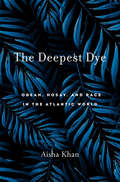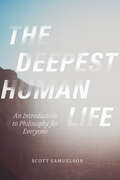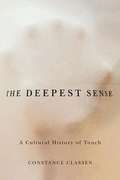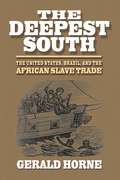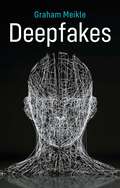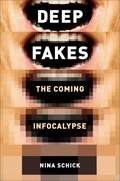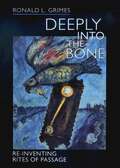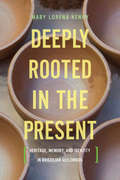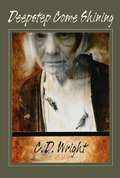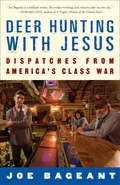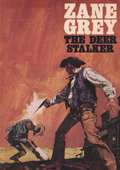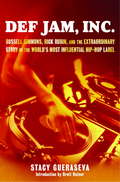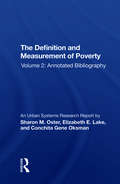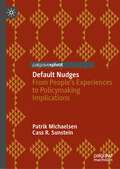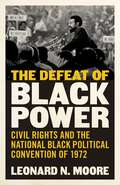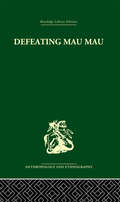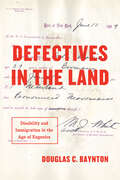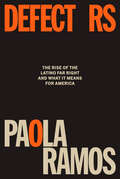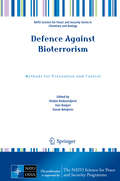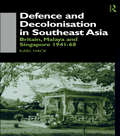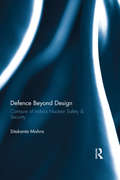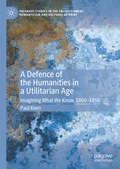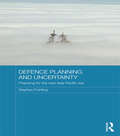- Table View
- List View
The Deepest Dye: Obeah, Hosay, and Race in the Atlantic World
by Aisha KhanHow colonial categories of race and religion together created identities and hierarchies that today are vehicles for multicultural nationalism and social critique in the Caribbean and its diasporas. When the British Empire abolished slavery, Caribbean sugar plantation owners faced a labor shortage. To solve the problem, they imported indentured “coolie” laborers, Hindus and a minority Muslim population from the Indian subcontinent. Indentureship continued from 1838 until its official end in 1917. The Deepest Dye begins on post-emancipation plantations in the West Indies—where Europeans, Indians, and Africans intermingled for work and worship—and ranges to present-day England, North America, and Trinidad, where colonial-era legacies endure in identities and hierarchies that still shape the post-independence Caribbean and its contemporary diasporas. Aisha Khan focuses on the contested religious practices of obeah and Hosay, which are racialized as “African” and “Indian” despite the diversity of their participants. Obeah, a catch-all Caribbean term for sub-Saharan healing and divination traditions, was associated in colonial society with magic, slave insurrection, and fraud. This led to anti-obeah laws, some of which still remain in place. Hosay developed in the West Indies from Indian commemorations of the Islamic mourning ritual of Muharram. Although it received certain legal protections, Hosay’s mass gatherings, processions, and mock battles provoked fears of economic disruption and labor unrest that lead to criminalization by colonial powers. The proper observance of Hosay was debated among some historical Muslim communities and continues to be debated now. In a nuanced study of these two practices, Aisha Khan sheds light on power dynamics through religious and racial identities formed in the context of colonialism in the Atlantic world, and shows how today these identities reiterate inequalities as well as reinforce demands for justice and recognition.
The Deepest Human Life: An Introduction to Philosophy for Everyone
by Scott SamuelsonThis accessible and thought-provoking introduction to philosophy shows how the eternal questions can shed light on our lives and struggles.These days, we generally leave philosophical matters to professional philosophers. Scott Samuelson thinks this is tragic, for our lives as well as for philosophy. In The Deepest Human Life, he restores philosophy to its proper place at the center of our humanity, rediscovering it as our most profound effort toward understanding, as a way of life that anyone can live. Exploring the works of some of history’s most important thinkers in the context of the everyday struggles of his students, Samuelson guides readers through the most vexing quandaries of existence—and shows just how enriching the examined life can be. Samuelson begins at the beginning: with Socrates, and the method he developed for approaching our greatest mysteries. From there he embarks on a journey through the history of philosophy, demonstrating how it is encoded in our own personal quests for meaning. Through heartbreaking stories, humanizing biographies, accessible theory, and evocative interludes like “On Wine and Bicycles” or “On Zombies and Superheroes,” Samuelson invests philosophy with the personal and vice versa. The result is a book that is at once a primer and a reassurance—that the most important questions endure, coming to life in each of us. Winner of the 2015 Hiett Prize in the Humanities
The Deepest Sense: A Cultural History of Touch
by Constance ClassenFrom the softest caress to the harshest blow, touch lies at the heart of our experience of the world. Now, for the first time, this deepest of senses is the subject of an extensive historical exploration. The Deepest Sense: A Cultural History of Touch fleshes out our understanding of the past with explorations of lived experiences of embodiment from the middle ages to modernity. This intimate and sensuous approach to history makes it possible to foreground the tactile foundations of Western culture--the ways in which feelings shaped society. Constance Classen explores a variety of tactile realms including the feel of the medieval city; the tactile appeal of relics; the social histories of pain, pleasure, and affection; the bonds of touch between humans and animals; the strenuous excitement of sports such as wrestling and jousting; and the sensuous attractions of consumer culture. She delves into a range of vital issues, from the uses--and prohibitions--of touch in social interaction to the disciplining of the body by the modern state, from the changing feel of the urban landscape to the technologization of touch in modernity. Through poignant descriptions of the healing power of a medieval king's hand or the grueling conditions of a nineteenth-century prison, we find that history, far from being a dry and lifeless subject, touches us to the quick.
The Deepest South: The United States, Brazil, and the African Slave Trade
by Gerald HorneA diplomatic history examining connections between the United States, Brazil, Africa, and Europe as they relate to the transatlantic slave trade. During its heyday in the nineteenth century, the African slave trade was fueled by the close relationship of the United States and Brazil. The Deepest South tells the disturbing story of how U.S. nationals—before and after Emancipation—continued to actively participate in this odious commerce by creating diplomatic, social, and political ties with Brazil, which today has the largest population of African origin outside of Africa itself. Based on extensive research from archives on five continents, Gerald Horne breaks startling new ground in the history of slavery, uncovering its global dimensions and the degrees to which its defenders went to maintain it.
The Deepest Well: Healing the Long-Term Effects of Childhood Adversity
by Nadine Burke HarrisA pioneering physician reveals how childhood stress leads to lifelong health problems and what we can do to break the cycle. Dr. Nadine Burke Harris was already known as a crusading physician delivering targeted care to vulnerable children. But it was Diego—a boy who had stopped growing after a sexual trauma—who galvanized her to dig deeper into the connections between toxic stress and the lifelong illnesses she was tracking among so many of her patients and their families. A survey of more than 17,000 adult patients’ “adverse childhood experiences,” or ACEs, like divorce, substance abuse, or neglect, had proved that the higher a person’s ACE score the worse their health—and now led Burke Harris to an astonishing breakthrough. Childhood stress changes our neural systems and lasts a lifetime. Through storytelling that delivers both scientific insight and moving stories of personal impact, Burke Harris illuminates her journey of discovery, from research labs nationwide to her own pediatric practice in San Francisco’s Bayview-Hunters Point. For anyone who has faced a difficult childhood, or who cares about the millions of children who do, the innovative and acclaimed health interventions outlined in The Deepest Well will represent vitally important hope for change.
Deepfakes
by Graham MeikleWhat happens when we can no longer believe what we see? Show the AI technologies that create deepfakes enough images of a celebrity or a politician and they will generate a convincing video in which that person appears to say and do things they have never actually said or done. The result is a media environment in which anyone&’s face and image can be remixed and manipulated. Graham Meikle explains how deepfakes (synthetic media) are made and used. From celebrity porn and political satire to movie mash-ups and disinformation campaigns, this book explores themes of trust and consent as face-swapping software becomes more common. Meikle argues that deepfake videos allow for a new perspective on the taken-for-granted nature of contemporary media, in which our capacity to remix and share content increasingly conflicts with our capacity to trust. The book analyses how such videos deepen the social media environment in which the public and the personal converge, and in which all human experience becomes data to be shared. Timely, clear, and accessibly written, this is an essential text for students and scholars of media, communication, cultural studies, and sociology as well as general readers.
Deepfakes: The Coming Infocalypse
by Nina SchickEverything you need to know about "deepfakes" and what could become the biggest information and communications meltdown in world history.In a world of deepfakes, it will soon be impossible to tell what is real and what isn't. As advances in artificial intelligence, video creation, and online trolling continue, deepfakes pose not only a real threat to democracy -- they threaten to take voter manipulation to unprecedented new heights. This crisis of misinformation which we now face has since been dubbed the "Infocalypse."In DEEPFAKES, investigative journalist Nina Schick uses her expertise from working in the field to reveal shocking examples of deepfakery and explain the dangerous political consequences of the Infocalypse, both in terms of national security and what it means for public trust in politics. This all-too-timely book also unveils what this all means for us as individuals, how deepfakes will be used to intimidate and to silence, for revenge and fraud, and just how truly unprepared governments and tech companies are for what's coming.
Deeply into the Bone: Re-inventing Rites Of Passage (Life Passages Ser. #Vol. 1)
by Ronald L. GrimesThis is a general introduction to the topic of rites of passage from a cross-cultural perspective.
Deeply Rooted in the Present: Heritage, Memory, and Identity in Brazilian Quilombos (Teaching Culture: UTP Ethnographies for the Classroom)
by Mary Lorena KennyAsking what it means to be quilombola (descendants of African slaves) in the twenty-first century, Kenny illustrates how heritage and identity do not simply exist, but are continually being constructed to reflect particular historical circumstances. The book includes supplementary exercises that encourage readers to make connections between the case study at hand, their own heritage, and heritage-making efforts in other parts of the world.
Deepstep Come Shining
by C. D. WrightRebellious and fiercely lyrical, the poems of C.D. Wright incorporate elements of disjunction and odd juxtaposition in their exploration of unfolding context. "In my book," she writes, "poetry is a necessity of life. It is a function of poetry to locate those zones inside us that would be free, and declare them so."C.D. Wright was born and raised in the Ozark Mountains of Arkansas. She has received numerous awards for her work, including grants from the National Endowment for the Arts, the Guggenheim Foundation, the American Academy and Institute for Arts and Letters, and the Lila Wallace-Reader's Digest Foundation. She teaches at Brown University in Rhode Island."Expertly elliptical phrasings, and an uncounterfeitable, generous feel for real people, bodies and places, have lately made Wright one of America's oddest, best and most appealing poets. Her tenth book consists of a single long poem whose sentences, segments and prose-blocks weave loosely around and about, and grow out of, a road trip through the rural South. Clipped twangs, lyrical 'goblets of magnolialight,' and recurrent, mysterious, semi-allegorical figures like 'the snakeman' and 'the boneman' share space with place names, lexicographies, exhortations and wacky graffiti ('God is Louise').... cherish Wright's latest 'once-and-for-all thing, opaque and revelatory, ceaselessly burning.'"--Publishers Weekly"For me, C.D. Wright's poetry is river gold. 'Love whatever flows.' Her language is on the page half pulled out of earth and rivers--still holding onto the truth of the elements. I love her voice and pitch and the long snaky arms of her language that is willing to hold everything--human and angry and beautiful."--Michael Ondaatje"C.D. Wright is entirely her own poet, a true original."--The Gettysburg Review
Deepwater Alchemy: Extractive Mediation and the Taming of the Seafloor
by Lisa Yin HanHow underwater mediation has transformed deep-sea spaces into resource-rich frontiers Green energy technologies such as windmills, solar panels, and electric vehicles may soon depend on material found at the seabed. How did a space once imagined to be empty and unfathomable come to be thought of as a treasure trove of resources? Lisa Yin Han traces how contemporary developments in underwater sensing and imaging materially and imaginatively transmogrify the ocean bottom into a resource frontier capable of sustaining a digitally connected global future. Set against the backdrop of climate change, energy transition, and the expansion of industrial offshore extractions, Deepwater Alchemy looks at oceanic media and its representation of the seabed in terms of valuable resources. From high-tech simulations to laboratories and archives that collect and analyze sediments, Han explores the media technologies that survey, visualize, and condition the possibility for industrial resource extraction, introducing the concept of extractive mediation to describe the conflations between resource prospecting and undersea knowledge production. Moving away from anthropocentric frameworks, she argues that we must equalize access to deep ocean mediation and include the submerged perspectives of multispecies communities. From the proliferation of petroleum seismology to environmental-impact research on seabed mining to the development of internet-enabled seafloor observatories, Deepwater Alchemy shows us that deepwater mediation is entangled in existential hopes and fears for our planetary future. As the ocean bottom becomes increasingly accessible to people, Han prompts us to ask not whether we can tame the seafloor, but, rather, why and for whom are we taming it?
Deer Hunting with Jesus: Dispatches from America's Class War
by Joe BageantA raucous, truth-telling look at the white working poor-and why they hate liberalism.Deer Hunting with Jesus is web columnist Joe Bageant's report on what he learned when he moved back to his hometown of Winchester, Virginia, which-like countless American small towns-is fast becoming the bedrock of a permanent underclass. By turns brutal, tender, incendiary, and seriously funny, this book is a call to arms for fellow progressives with little real understanding of "the great beery, NASCAR-loving, church-going, gun-owning America that has never set foot in a Starbucks."
The Deer Stalker: A Western Story
by Zane GreyOriginally published in 1925, in THE DEER STALKER, Zane Grey readers will find all they have come to expect from their favorite Western author—swift action, magnificent descriptions of the desert and canyon country, plus the added valiant effort of a ranger’s struggle to save the doomed herd of deer on the Buckskin range.Zane Grey makes the reader see this colorful Arizona country, makes him feel something of the awe that is the inevitable reaction of man to the majesty of one of nature’s miracles, makes him smell the tang of mingled pine and sagebrush, makes him thrill to the heroic struggle of a few dedicated men as they battle to undo the harm of the willful and greedy.
Def Jam, Inc.: Russell Simmons, Rick Rubin, and the Extraordinary Story of the World's Most Influential Hip-hop Label
by Brett Ratner Stacy GuerasevaIn the early '80s, the music industry wrote off hip-hop as a passing fad. Few could or would have predicted that the improvised raps and raw beats busting out of New York City's urban underclass would one day become a multimillion-dollar business and one of music's most lucrative genres. Among those few were two visionaries: Russell Simmons, a young black man from Hollis, Queens, and Rick Rubin, a Jewish kid from Long Island. Though the two came from different backgrounds, their all-consuming passion for hip-hop brought them together. Soon they would revolutionize the music industry with their groundbreaking label, Def Jam Records.Def Jam, Inc. traces the company's incredible rise from the NYU dorm room of nineteen-year-old Rubin (where LL Cool J was discovered on a demo tape) to the powerhouse it is today; from financial struggles and scandals-including The Beastie Boys's departure from the label and Rubin's and Simmons's eventual parting-to revealing anecdotes about artists like Slick Rick, Public Enemy, Foxy Brown, Jay-Z, and DMX. Stacy Gueraseva, former editor in chief of Russell Simmons's magazine, Oneworld, had access to the biggest players on the scene, and brings you real conversations and a behind-the-scenes look from a decade-and a company-that turned the music world upside down. She takes you back to New York in the '80s, when late-night spots such as Danceteria and Nell's were burning with young, fresh rappers, and Simmons and Rubin had nothing but a hunch that they were on to something huge.Far more than just a biography of the two men who made it happen, Def Jam, Inc. is a journey into the world of rap itself. Both an intriguing business history as well as a gritty narrative, here is the definitive book on Def Jam--a must read for any fan of hip-hop as well as all popular-culture junkies.
Def-measuremnt Poverty-2/h
by Sharon M. OsterAre the poor, as one writer suggests, only those without enough to eat? Or does poverty instead consist of "the inability to buy a beer when everyone else has one"? These two volumes provide a comprehensive summary and annotated bibliography of the issues associated with the definition and measurement of poverty. The discussion is organized around eleven topics in the areas of economics, political science, and sociology. Included are such diverse subjects as the historical evolution of poverty definitions (How did Karl Marx and Adam Smith define poverty?); the "index number" problem; and regional differences in poverty measurement. The annotated bibliography, including both articles and books, primarily covers material written after 1950.
Default Nudges: From People's Experiences to Policymaking Implications
by Patrik Michaelsen Cass R. SunsteinAll over the world, private and public institutions have been attracted to “nudges,” understood as interventions that preserve freedom of choice, but that steer people in particular directions. The most effective nudges are often “defaults,” which establish what happens if people do nothing. For example, automatic enrollment in savings plans is a default nudge, as is automatic enrollment in green energy. Default rules are in widespread use, but we have very little information about how people experience them, whether they see themselves as manipulated by them, and whether they approve of them in practice. In this book, Patrik Michaelsen and Cass R. Sunstein offer a wealth of new evidence about people’s experiences and perceptions with respect to default rules. They argue that this evidence can help us to answer important questions about the effectiveness and ethics of nudging. The evidence offers a generally positive picture of how default nudges are perceived and experienced. The central conclusion is simple: empirical findings strongly support the conclusion that, taken as such, default nudges are both ethical and effective. These findings, and the accompanying discussion, have significant implications for policymakers in many nations, and also for the private sector.
The Defeat of Black Power: Civil Rights and the National Black Political Convention of 1972
by Leonard N. MooreFor three days in 1972 in Gary, Indiana, eight thousand American civil rights activists and Black Power leaders gathered at the National Black Political Convention, hoping to end a years-long feud that divided black America into two distinct camps: integrationists and separatists. While some form of this rift existed within black politics long before the 1968 assassination of Dr. Martin Luther King, Jr., his death—and the power vacuum it created—heightened tensions between the two groups, and convention leaders sought to merge these competing ideologies into a national, unified call to action. What followed, however, effectively crippled the Black Power movement and fundamentally altered the political strategy of civil rights proponents. An intense and revealing history, Leonard N. Moore’s The Defeat of Black Power provides the first in-depth evaluation of this critical moment in American history.During the brief but highly charged meeting in March 1972, attendees confronted central questions surrounding black people’s involvement in the established political system: reject or accept integration and assimilation; determine the importance or futility of working within the broader white system; and assess the perceived benefits of running for public office. These issues illuminated key differences between integrationists and separatists, yet both sides understood the need to mobilize under a unified platform of black self-determination. At the end of the convention, determined to reach a consensus, officials produced “The National Black Political Agenda,” which addressed the black constituency’s priorities. While attendees and delegates agreed with nearly every provision, integrationists maintained their rejection of certain planks, namely the call for a U.S. constitutional convention and separatists’ demands for reparations. As a result, black activists and legislators withdrew their support less than ten weeks after the convention, dashing the promise of the 1972 assembly and undermining the prerogatives of black nationalists. In The Defeat of Black Power, Moore shows how the convention signaled a turning point for the Black Power movement, whose leaders did not hold elective office and were now effectively barred access to the levers of social and political power. Thereafter, their influence within black communities rapidly declined, leaving civil rights activists and elected officials holding the mantle of black political leadership in 1972 and beyond.
Defeating Mau Mau
by Louis LeakeyThe second of two important books by Louis Leakey, the renowned expert on the Kikuyu tribe. This book examines the organisation of the Mau Mau movement, its propaganda, the nature of its religious aspects and its oaths and the mistakes its leaders made as well as covering chapters on necessary reforms to prevent further outbreaks of a similar nature.
Defectives in the Land: Disability and Immigration in the Age of Eugenics
by Douglas C. BayntonImmigration history has largely focused on the restriction of immigrants by race and ethnicity, overlooking disability as a crucial factor in the crafting of the image of the "undesirable immigrant." Defectives in the Land, Douglas C. Baynton's groundbreaking new look at immigration and disability, aims to change this. In the late nineteenth and early twentieth centuries, Baynton explains, immigration restriction in the United States was primarily intended to keep people with disabilities--known as "defectives"--out of the country. The list of those included is long: the deaf, blind, epileptic, and mobility impaired; people with curved spines, hernias, flat or club feet, missing limbs, and short limbs; those unusually short or tall; people with intellectual or psychiatric disabilities; intersexuals; men of "poor physique" and men diagnosed with "feminism." Not only were disabled individuals excluded, but particular races and nationalities were also identified as undesirable based on their supposed susceptibility to mental, moral, and physical defects. In this transformative book, Baynton argues that early immigration laws were a cohesive whole--a decades-long effort to find an effective method of excluding people considered to be defective. This effort was one aspect of a national culture that was increasingly fixated on competition and efficiency, anxious about physical appearance and difference, and haunted by a fear of hereditary defect and the degeneration of the American race.
Defectors: The Rise of the Latino Far Right and What It Means for America
by Paola RamosAN NPR BEST BOOK OF 2024 • An award-winning journalist's exploration of how race, identity and political trauma have influenced the rise in far-right sentiment among Latinos, and how this group can shape American politics &“A deeply reported, surprisingly personal exploration of a phenomenon that is little understood in our politics: the affiliation of Latino voters with causes and candidates that would seem, at first glance, unwelcoming to them." —Rachel MaddowDemocrats have historically assumed they can rely on the Latino vote, but recent elections have called that loyalty into question. In fact, despite his vociferous anti-immigrant rhetoric and disastrous border policies, Trump won a higher percentage of the Latino vote in 2020 than he did in 2016. Now, journalist Paola Ramos pulls back the curtain on these voters, traveling around the country to uncover what motivates them to vote for and support issues that seem so at odds with their self-interest.From coast to coast, cities to rural towns, Defectors introduces readers to underdog GOP candidates, January 6th insurrectionists, Evangelical pastors and culture war crusaders, aiming to identify the influences at the heart of this rightward shift. Through their stories, Ramos shows how tribalism, traditionalism, and political trauma within the Latino community has been weaponized to radicalize and convert voters who, like many of their white counterparts, are fearful of losing their place in American society.We meet Monica de la Cruz, a Republican congresswoman from the Rio Grande Valley who won on a platform centered on finishing &“what Donald Trump started&” and pushing the Great Replacement Theory; David Ortiz, a Mexican man who refers to himself as a Spaniard and opposed the removal of a statue of a Spanish conquistador in New Mexico; Luis Cabrera, an evangelical pastor pushing to &“Make America Godly Again;&” Anthony Aguero, an independent journalist turned border vigilante; and countless other individuals and communities that make up the rising conservative Latino population. Cross-cultural and assiduously reported, Defectors highlights how one of America's most powerful and misunderstood electorates may come to define the future of American politics.
Defence Against Bioterrorism: Methods For Prevention And Control (NATO Science For Peace And Security Series B: Physics and Biophysics)
by Vladan Radosavljevic Goran Belojevic Ines BanjariThis volume is based on a multidisciplinary approach towards biological and chemical threats that can, and have been previously used in bioterrorism attacks around the globe. Current knowledge and evidence-based principles from the fields of synthetic biology, microbiology, plant biology, chemistry, food science, forensics, tactics, infective medicine, psychology and others are compiled to address numerous aspects and the complexity of bioterrorism attacks. The main focus is on biological threats, especially in the context of synthetic biology and its emerging findings that can be observed as possible threat and tool. The book examines microorganisms and their possible use in forensics, i.e. as possible detection tool that could enable fast and precise detection of possible treats. A number of plant derived components are also discussed as possible agents in bioterrorism attacks, and in relation to infectious disease pathology. Another integral part is food safety, especially in terms of large food supply chains, like airline caterings, institutionalized kitchens etc. Food can be observed as a possible mean of delivery of various agents (biological and chemical) for bioterrorism attacks. Steps on how to recognize specific critical points in a food supply chain, along with proposed corrective activities are discussed.Examples from around the globe, along with the methodological approach on how to differentiate bioterrorism attacks from other epidemics are provided. However, epidemics are also discussed in the context of migrations, with the special emphasis on the current refugee migrations that affect not only Europe, but also the United States. The book will be of interest to experts from various fields of science as well as professionals working in the field. The book encompasses examples and tools developed for easier, more specific, and faster detection of possible bioterrorism treats, along with proposed actions for some aspects of a bioterrorism attack.
Defence and Decolonisation in South-East Asia: Britain, Malaya and Singapore 1941-1967
by Karl HackThis book explains why British defence policy and practice emerged as it did in the period 1941-67, by looking at the overlapping of colonial, military, economic and Cold War factors in the area. Its main focus is on the 1950s and the decolonisation era, but it argues that the plans and conditions of this period can only be understood by tracing them back to their origins in the fall of Singapore. Also, it shows how decolonisation was shaped not just by British aims, but by the way communism, communalism and nationalism facilitated and frustrated these.
Defence Beyond Design: Contours of India’s Nuclear Safety and Security
by Sitakanta MishraThis book scrutinises the realm of safety-security involving ‘nuclear power’ within the context of India’s tryst with nuclear energy. Relying on open source information, it examines the efficacy of the safety-security arrangement in and around India’s nuclear installations, keeping in mind the international best practices. As India has embarked on a civil nuclear expansion programme, the public concern for safety and security of nuclear facilities and material is obvious, especially in the backdrop of terrorist incidents and the Fukushima disaster. This poses a serious challenge to garnering greater domestic support for new nuclear projects with international collaborations. Here an attempt is made to examine the issues involving social acceptance of nuclear energy, safe disposal of nuclear waste, regulatory practices, and likely challenges ahead for India, to propose a new nuclear safety-security paradigm by looking beyond the usual ‘defence by design’ or ‘defence in-depth’ practice. Please note: Taylor & Francis does not sell or distribute the Hardback in India, Pakistan, Nepal, Bhutan, Bangladesh and Sri Lanka
A Defence of the Humanities in a Utilitarian Age: Imagining What We Know, 1800-1850 (Palgrave Studies in the Enlightenment, Romanticism and Cultures of Print)
by Paul KeenThis book explores the ways that critics writing in the early nineteenth century developed arguments in favour of the humanities in the face of utilitarian pressures. Its focus reflects the ways that similar pressures today have renewed the question of how to make the case for the public value of the humanities. The good news is that in many ways, this self-reflexive challenge is precisely what the humanities have always done best: highlight the nature and the force of the narratives that have helped to define how we understand our society – its various pasts and its possible futures – and to suggest the larger contexts within which these issues must ultimately be situated.
Defence Planning and Uncertainty: Preparing for the Next Asia-Pacific War (Routledge Security in Asia Pacific Series)
by Stephan FrühlingHow can countries decide what kind of military forces they need, if threats are uncertain and history is full of strategic surprises? This is a question that is more pertinent than ever, as countries across the Asia-Pacific are faced with the military and economic rise of China. Uncertainty is inherent in defence planning, but different types of uncertainty mean that countries need to approach decisions about military force structure in different ways. This book examines four different basic frameworks for defence planning, and demonstrates how states can make decisions coherently about the structure and posture of their defence forces despite strategic uncertainty. It draws on case studies from the United States, Australian and New Zealand, each of which developed key concepts for their particular circumstances and risk perception in Asia. Success as well as failure in developing coherent defence planning frameworks holds lessons for the United States and other countries as they consider how best to structure their military forces for the uncertain challenges of the future.
